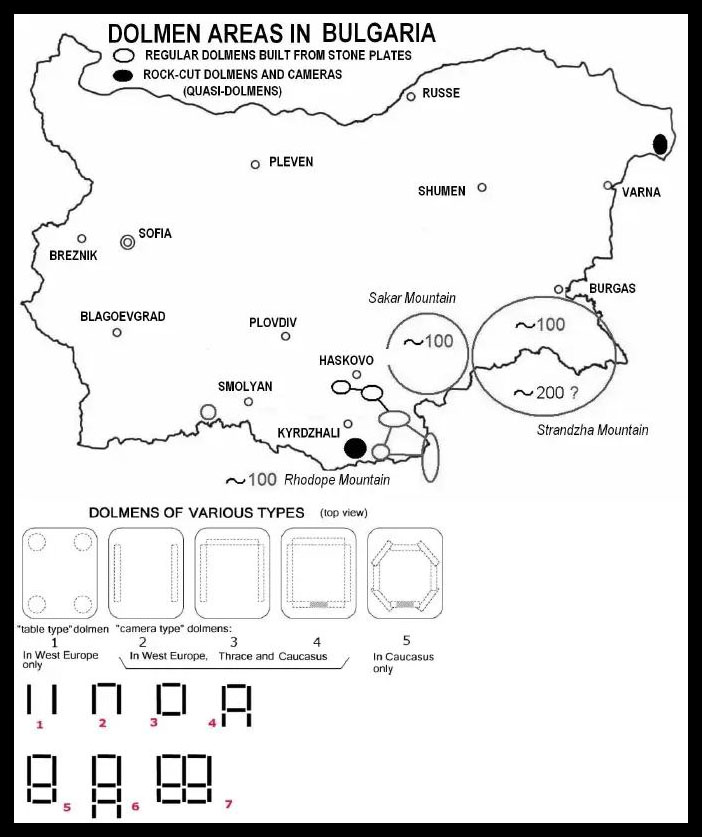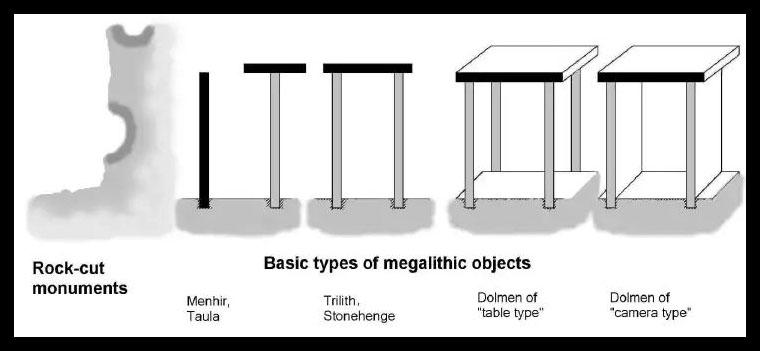Brit-Am Megalithic Bulletin Update
(4 November, 2019, 6 Cheshvan, 5780)
Contents:
1. Barash (continued)
RESEARCH ARTICLE. Dolmens in Israel, Shamir Field
2. Bulgaria Balkan megaliths
3. THRACIAN MEGALITHS: TYPOLOGY, CONSTRUCTION, STATE
^^^^^^^^
1. Barash (continued)
Relevance. Different types of Dolmens in Israel. Links to dolmens in Syria and Turkey
RESEARCH ARTICLE. Dolmens in Israel, Shamir Field
Monumental megalithic burial and rock art tell a new story about the Levant Intermediate Bronze 'Dark Ages'
Gonen Sharon ,
Alon Barash,
Davida Eisenberg-Degen,
Leore Grosman,
Maya Oron,
Uri Berger
https://journals.plos.org/plosone/article?id=10.1371/journal.pone.0172969
See BAMBU-18 no. 8
Additional Extracts:
These new discoveries support the suggestion that the dolmens of the Golan (north of the Yarmuk River) and Galilee should be distinguished from the dolmens east of the Southern Jordan Rift Valley. The Golan dolmens differ from the southern dolmens in the type of rock used for their construction (basalt vs limestone and sandstone), in size (they are typically much larger), in their design (typically passage tombs covered by a constructed tumulus), building technology (unworked stones), and in their chronology. It seems that the Golan and Galilee dolmens find their cultural roots in the north, in the megalithic traditions of Syria and Anatolia. In all of the many dolmens excavated and surveyed in the Golan and its escarpments, the earliest material unearthed clearly belongs to the Intermediate Bronze Age [24,25,34].
presence of beads

^^^^^^^^
2. Bulgaria Balkan Megaliths
Relevance. Links Caucasus and Mediterranean Dolmens. Possible to prove contingency Mycenean and later epochs of diolmens.
Tsonev, L.V.; Kolev, D.Z. Megalithic structures and dolmen orientation in Bulgaria
https://www.academia.edu/11679387/Tsonev_L.V._Kolev_D.Z._Megalithic_structures_and_dolmen_orientation_in_Bulgaria
Journal Archaeoastronomy and Ancient Technologies
Lyubomir Tsonev
Dimitar Kolev
Good Illustrations AND MAPS

The Balkan megaliths are concentrated in the East and South-East regions of Bulgaria, some dolmens are registered also in North-East Greece and in North-West Turkey.
MEGALITHS ULTIMATELY REPLACED BY MICROLITHS. Greek and Roman influence.
Balkan megalithic area interacts not only with West Mediterranean culture (Malta etc.), but also with East megalithic centers like Caucasus (West Caucasus dolmens) [6], Armenia (menhirs in Zangezur) [7] and Ural (various
Menhirs are found in principle not only as isolated stone blocks but also as combinations of rock pillars fixed into the ground, each combination being planned and interpreted as a common sacralobject: alignments, cromlechs and grids
800 to 200 dolmens.
In Thrace only 'camera type' dolmens have been built with a great diversity of constructions
The most perfect example of stone plates circle on the Balkan Peninsula is situated in Mycenae and enveloping
the famous kings tombs.
^^^^^^^^
3. THRACIAN MEGALITHS: TYPOLOGY, CONSTRUCTION, STATE
Lyubomir Vladimirov Tsonev, Dimiter Zdravkov Kolev, Yanko Dinkov Dinchev
https://www.academia.edu/21457348/THRACIAN_MEGALITHS_TYPOLOGY_CONSTRUCTION_STATE

Relevance:
Summary of Dolmen types and places.
We present a review of the typology, construction and the present state of the Balkan megaliths (menhirs and dolmens) using examples from Bulgaria. The dolmen field in Sakar mount. is the most uniform and preserved in Bulgarian territory and gives good examples for studying the constructive principles in building dolmens. The need of preservation and protection of these objects is discussed as well as their socialization and inserting in the touristic routes.
![[]](https://html2-f.scribdassets.com/6wx1wkqngg50b3sy/images/3-ebbff899ca.jpg)
Extracts:
There exist 3 main megalithic fields in Europe;
(A) West Europe: UK, Ireland,Sweden, Denmark, Holland, North Germany, France, Portugal, Spain, Balearics, Sardinia,Corsica, Malta, South Italy,
(B) Balkans: Bulgaria, European Turkey, Greece,
(C) Caucasus: West Caucasus and Armenia.
at least R constructive dolmen types over Europe, Fig, 3
1. table
2 to 4. camera,with different number of vertical walls (2 to 4) and
5. cylinder, prismatic camera.
See picture.
